Advances in Technology and Jobs: Impacts, Challenges and Solutions
VerifiedAdded on 2021/09/16
|6
|1436
|304
Essay
AI Summary
This essay critically examines the advancements in technology, specifically robotics, artificial intelligence, and automation, and their impact on the job market. It discusses the curtailment of jobs due to technological progress across various industries, including travel, news, retail, and finance. The essay highlights the challenges faced by policymakers, industries, and workers and proposes solutions such as investing in human capital, fostering public-private sector partnerships, and focusing on creativity, critical thinking, and lifelong learning. It concludes that the future workforce needs to be more educated, skilled, and adaptable to thrive alongside technology, emphasizing the importance of multi-skilling and continuous learning to address the concerns arising from technological advancements in the workplace. Desklib provides similar resources for students.
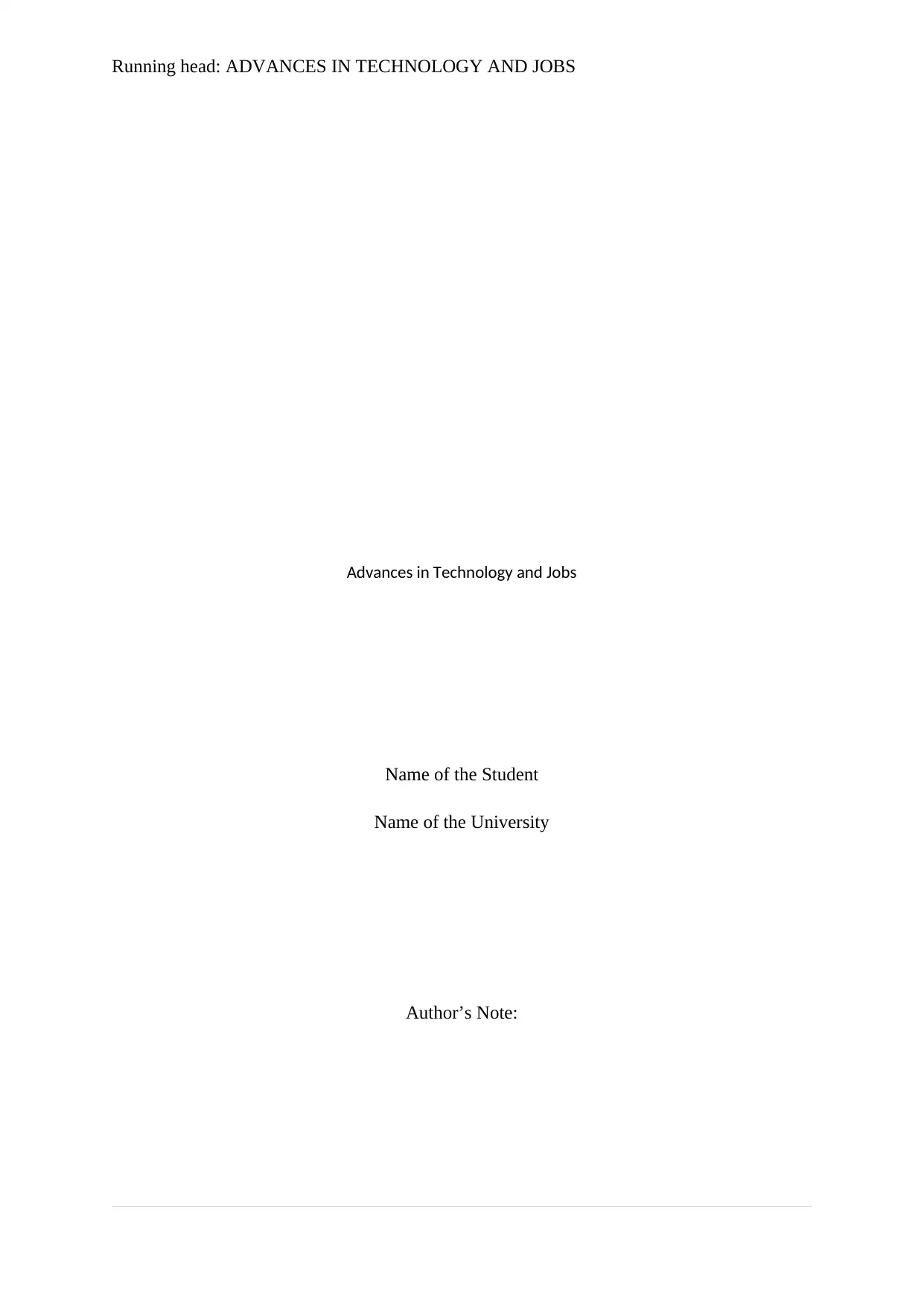
Running head: ADVANCES IN TECHNOLOGY AND JOBS
Advances in Technology and Jobs
Name of the Student
Name of the University
Author’s Note:
Advances in Technology and Jobs
Name of the Student
Name of the University
Author’s Note:
Paraphrase This Document
Need a fresh take? Get an instant paraphrase of this document with our AI Paraphraser
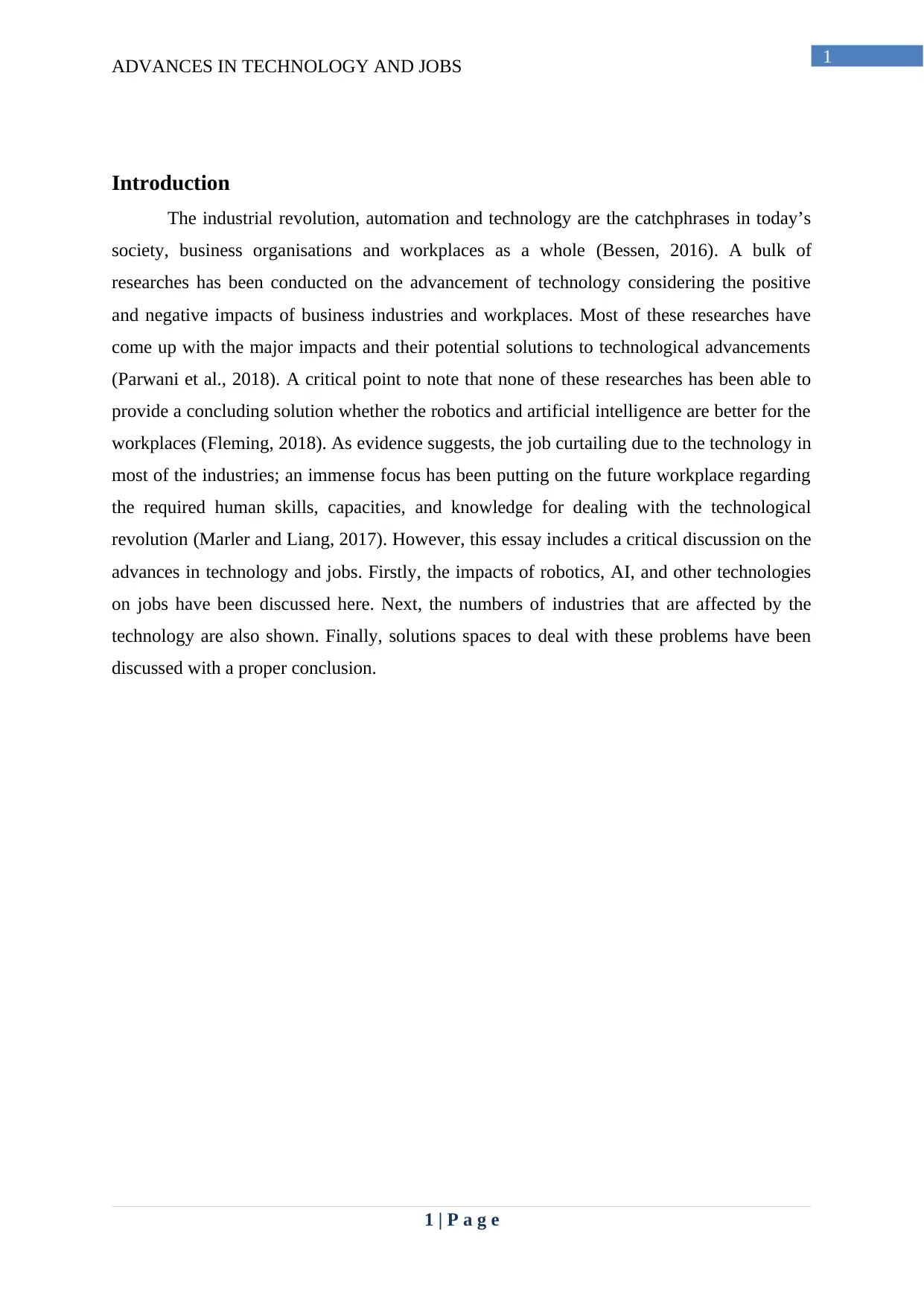
1
ADVANCES IN TECHNOLOGY AND JOBS
Introduction
The industrial revolution, automation and technology are the catchphrases in today’s
society, business organisations and workplaces as a whole (Bessen, 2016). A bulk of
researches has been conducted on the advancement of technology considering the positive
and negative impacts of business industries and workplaces. Most of these researches have
come up with the major impacts and their potential solutions to technological advancements
(Parwani et al., 2018). A critical point to note that none of these researches has been able to
provide a concluding solution whether the robotics and artificial intelligence are better for the
workplaces (Fleming, 2018). As evidence suggests, the job curtailing due to the technology in
most of the industries; an immense focus has been putting on the future workplace regarding
the required human skills, capacities, and knowledge for dealing with the technological
revolution (Marler and Liang, 2017). However, this essay includes a critical discussion on the
advances in technology and jobs. Firstly, the impacts of robotics, AI, and other technologies
on jobs have been discussed here. Next, the numbers of industries that are affected by the
technology are also shown. Finally, solutions spaces to deal with these problems have been
discussed with a proper conclusion.
1 | P a g e
ADVANCES IN TECHNOLOGY AND JOBS
Introduction
The industrial revolution, automation and technology are the catchphrases in today’s
society, business organisations and workplaces as a whole (Bessen, 2016). A bulk of
researches has been conducted on the advancement of technology considering the positive
and negative impacts of business industries and workplaces. Most of these researches have
come up with the major impacts and their potential solutions to technological advancements
(Parwani et al., 2018). A critical point to note that none of these researches has been able to
provide a concluding solution whether the robotics and artificial intelligence are better for the
workplaces (Fleming, 2018). As evidence suggests, the job curtailing due to the technology in
most of the industries; an immense focus has been putting on the future workplace regarding
the required human skills, capacities, and knowledge for dealing with the technological
revolution (Marler and Liang, 2017). However, this essay includes a critical discussion on the
advances in technology and jobs. Firstly, the impacts of robotics, AI, and other technologies
on jobs have been discussed here. Next, the numbers of industries that are affected by the
technology are also shown. Finally, solutions spaces to deal with these problems have been
discussed with a proper conclusion.
1 | P a g e
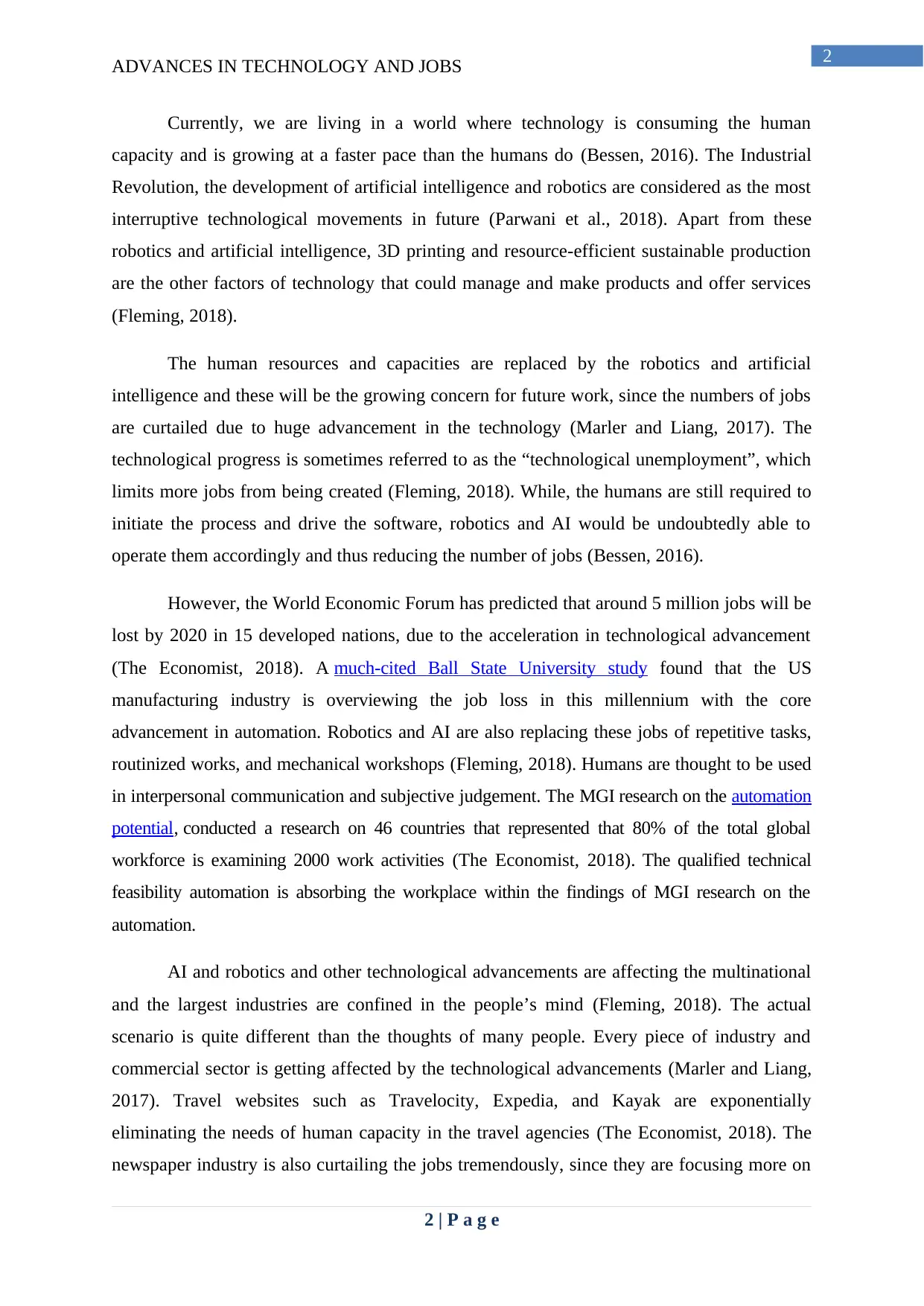
2
ADVANCES IN TECHNOLOGY AND JOBS
Currently, we are living in a world where technology is consuming the human
capacity and is growing at a faster pace than the humans do (Bessen, 2016). The Industrial
Revolution, the development of artificial intelligence and robotics are considered as the most
interruptive technological movements in future (Parwani et al., 2018). Apart from these
robotics and artificial intelligence, 3D printing and resource-efficient sustainable production
are the other factors of technology that could manage and make products and offer services
(Fleming, 2018).
The human resources and capacities are replaced by the robotics and artificial
intelligence and these will be the growing concern for future work, since the numbers of jobs
are curtailed due to huge advancement in the technology (Marler and Liang, 2017). The
technological progress is sometimes referred to as the “technological unemployment”, which
limits more jobs from being created (Fleming, 2018). While, the humans are still required to
initiate the process and drive the software, robotics and AI would be undoubtedly able to
operate them accordingly and thus reducing the number of jobs (Bessen, 2016).
However, the World Economic Forum has predicted that around 5 million jobs will be
lost by 2020 in 15 developed nations, due to the acceleration in technological advancement
(The Economist, 2018). A much-cited Ball State University study found that the US
manufacturing industry is overviewing the job loss in this millennium with the core
advancement in automation. Robotics and AI are also replacing these jobs of repetitive tasks,
routinized works, and mechanical workshops (Fleming, 2018). Humans are thought to be used
in interpersonal communication and subjective judgement. The MGI research on the automation
potential, conducted a research on 46 countries that represented that 80% of the total global
workforce is examining 2000 work activities (The Economist, 2018). The qualified technical
feasibility automation is absorbing the workplace within the findings of MGI research on the
automation.
AI and robotics and other technological advancements are affecting the multinational
and the largest industries are confined in the people’s mind (Fleming, 2018). The actual
scenario is quite different than the thoughts of many people. Every piece of industry and
commercial sector is getting affected by the technological advancements (Marler and Liang,
2017). Travel websites such as Travelocity, Expedia, and Kayak are exponentially
eliminating the needs of human capacity in the travel agencies (The Economist, 2018). The
newspaper industry is also curtailing the jobs tremendously, since they are focusing more on
2 | P a g e
ADVANCES IN TECHNOLOGY AND JOBS
Currently, we are living in a world where technology is consuming the human
capacity and is growing at a faster pace than the humans do (Bessen, 2016). The Industrial
Revolution, the development of artificial intelligence and robotics are considered as the most
interruptive technological movements in future (Parwani et al., 2018). Apart from these
robotics and artificial intelligence, 3D printing and resource-efficient sustainable production
are the other factors of technology that could manage and make products and offer services
(Fleming, 2018).
The human resources and capacities are replaced by the robotics and artificial
intelligence and these will be the growing concern for future work, since the numbers of jobs
are curtailed due to huge advancement in the technology (Marler and Liang, 2017). The
technological progress is sometimes referred to as the “technological unemployment”, which
limits more jobs from being created (Fleming, 2018). While, the humans are still required to
initiate the process and drive the software, robotics and AI would be undoubtedly able to
operate them accordingly and thus reducing the number of jobs (Bessen, 2016).
However, the World Economic Forum has predicted that around 5 million jobs will be
lost by 2020 in 15 developed nations, due to the acceleration in technological advancement
(The Economist, 2018). A much-cited Ball State University study found that the US
manufacturing industry is overviewing the job loss in this millennium with the core
advancement in automation. Robotics and AI are also replacing these jobs of repetitive tasks,
routinized works, and mechanical workshops (Fleming, 2018). Humans are thought to be used
in interpersonal communication and subjective judgement. The MGI research on the automation
potential, conducted a research on 46 countries that represented that 80% of the total global
workforce is examining 2000 work activities (The Economist, 2018). The qualified technical
feasibility automation is absorbing the workplace within the findings of MGI research on the
automation.
AI and robotics and other technological advancements are affecting the multinational
and the largest industries are confined in the people’s mind (Fleming, 2018). The actual
scenario is quite different than the thoughts of many people. Every piece of industry and
commercial sector is getting affected by the technological advancements (Marler and Liang,
2017). Travel websites such as Travelocity, Expedia, and Kayak are exponentially
eliminating the needs of human capacity in the travel agencies (The Economist, 2018). The
newspaper industry is also curtailing the jobs tremendously, since they are focusing more on
2 | P a g e
⊘ This is a preview!⊘
Do you want full access?
Subscribe today to unlock all pages.

Trusted by 1+ million students worldwide
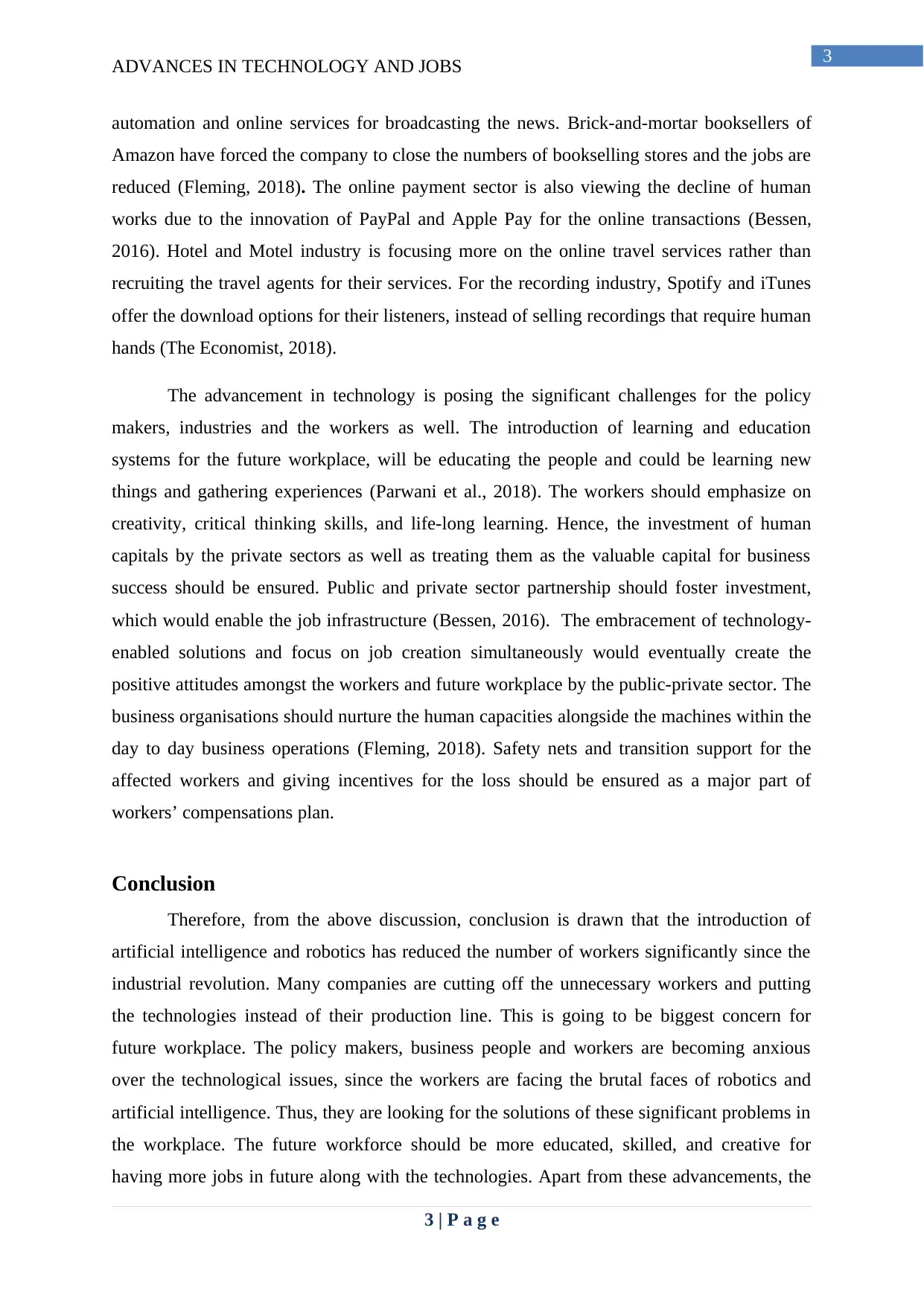
3
ADVANCES IN TECHNOLOGY AND JOBS
automation and online services for broadcasting the news. Brick-and-mortar booksellers of
Amazon have forced the company to close the numbers of bookselling stores and the jobs are
reduced (Fleming, 2018). The online payment sector is also viewing the decline of human
works due to the innovation of PayPal and Apple Pay for the online transactions (Bessen,
2016). Hotel and Motel industry is focusing more on the online travel services rather than
recruiting the travel agents for their services. For the recording industry, Spotify and iTunes
offer the download options for their listeners, instead of selling recordings that require human
hands (The Economist, 2018).
The advancement in technology is posing the significant challenges for the policy
makers, industries and the workers as well. The introduction of learning and education
systems for the future workplace, will be educating the people and could be learning new
things and gathering experiences (Parwani et al., 2018). The workers should emphasize on
creativity, critical thinking skills, and life-long learning. Hence, the investment of human
capitals by the private sectors as well as treating them as the valuable capital for business
success should be ensured. Public and private sector partnership should foster investment,
which would enable the job infrastructure (Bessen, 2016). The embracement of technology-
enabled solutions and focus on job creation simultaneously would eventually create the
positive attitudes amongst the workers and future workplace by the public-private sector. The
business organisations should nurture the human capacities alongside the machines within the
day to day business operations (Fleming, 2018). Safety nets and transition support for the
affected workers and giving incentives for the loss should be ensured as a major part of
workers’ compensations plan.
Conclusion
Therefore, from the above discussion, conclusion is drawn that the introduction of
artificial intelligence and robotics has reduced the number of workers significantly since the
industrial revolution. Many companies are cutting off the unnecessary workers and putting
the technologies instead of their production line. This is going to be biggest concern for
future workplace. The policy makers, business people and workers are becoming anxious
over the technological issues, since the workers are facing the brutal faces of robotics and
artificial intelligence. Thus, they are looking for the solutions of these significant problems in
the workplace. The future workforce should be more educated, skilled, and creative for
having more jobs in future along with the technologies. Apart from these advancements, the
3 | P a g e
ADVANCES IN TECHNOLOGY AND JOBS
automation and online services for broadcasting the news. Brick-and-mortar booksellers of
Amazon have forced the company to close the numbers of bookselling stores and the jobs are
reduced (Fleming, 2018). The online payment sector is also viewing the decline of human
works due to the innovation of PayPal and Apple Pay for the online transactions (Bessen,
2016). Hotel and Motel industry is focusing more on the online travel services rather than
recruiting the travel agents for their services. For the recording industry, Spotify and iTunes
offer the download options for their listeners, instead of selling recordings that require human
hands (The Economist, 2018).
The advancement in technology is posing the significant challenges for the policy
makers, industries and the workers as well. The introduction of learning and education
systems for the future workplace, will be educating the people and could be learning new
things and gathering experiences (Parwani et al., 2018). The workers should emphasize on
creativity, critical thinking skills, and life-long learning. Hence, the investment of human
capitals by the private sectors as well as treating them as the valuable capital for business
success should be ensured. Public and private sector partnership should foster investment,
which would enable the job infrastructure (Bessen, 2016). The embracement of technology-
enabled solutions and focus on job creation simultaneously would eventually create the
positive attitudes amongst the workers and future workplace by the public-private sector. The
business organisations should nurture the human capacities alongside the machines within the
day to day business operations (Fleming, 2018). Safety nets and transition support for the
affected workers and giving incentives for the loss should be ensured as a major part of
workers’ compensations plan.
Conclusion
Therefore, from the above discussion, conclusion is drawn that the introduction of
artificial intelligence and robotics has reduced the number of workers significantly since the
industrial revolution. Many companies are cutting off the unnecessary workers and putting
the technologies instead of their production line. This is going to be biggest concern for
future workplace. The policy makers, business people and workers are becoming anxious
over the technological issues, since the workers are facing the brutal faces of robotics and
artificial intelligence. Thus, they are looking for the solutions of these significant problems in
the workplace. The future workforce should be more educated, skilled, and creative for
having more jobs in future along with the technologies. Apart from these advancements, the
3 | P a g e
Paraphrase This Document
Need a fresh take? Get an instant paraphrase of this document with our AI Paraphraser
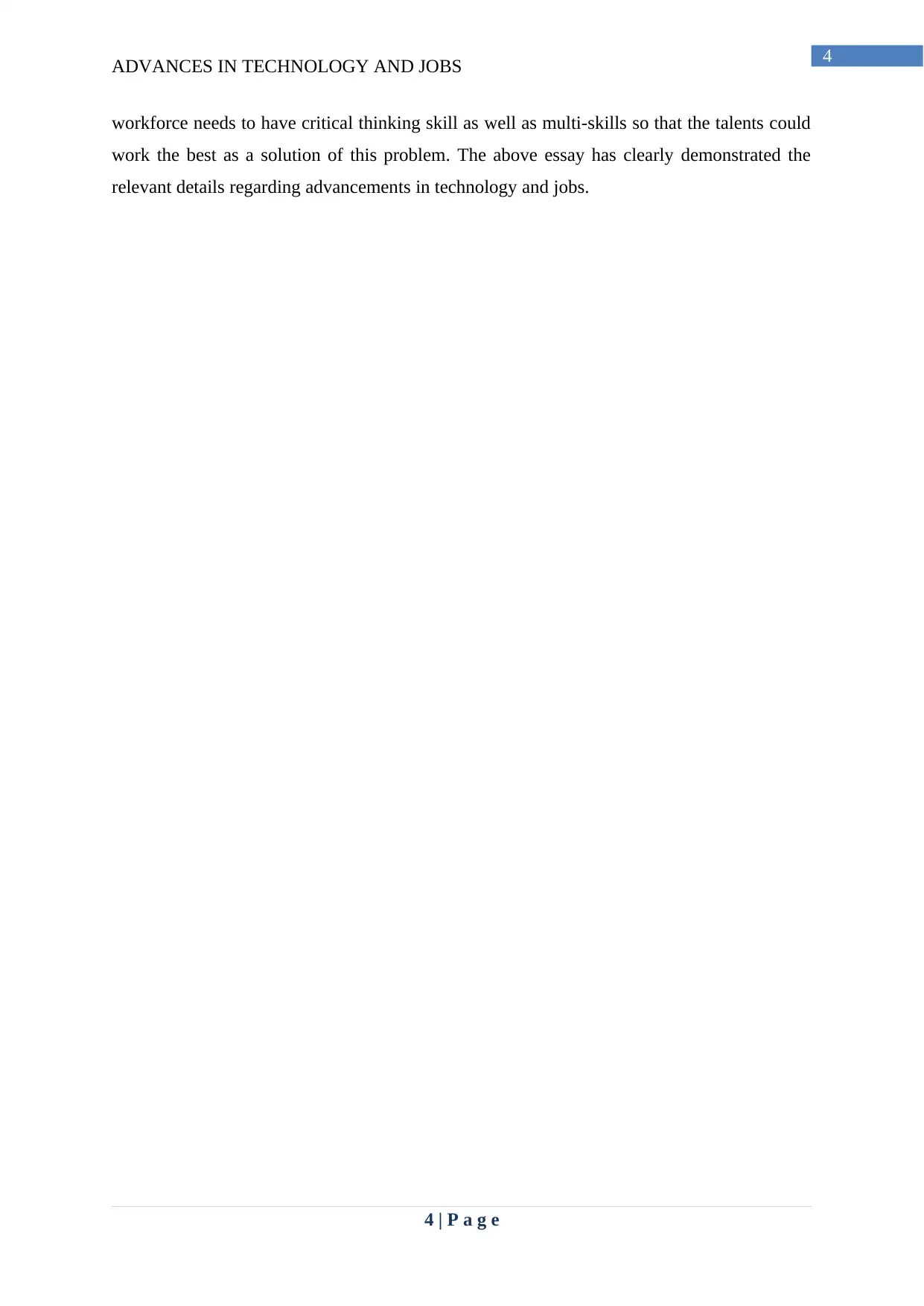
4
ADVANCES IN TECHNOLOGY AND JOBS
workforce needs to have critical thinking skill as well as multi-skills so that the talents could
work the best as a solution of this problem. The above essay has clearly demonstrated the
relevant details regarding advancements in technology and jobs.
4 | P a g e
ADVANCES IN TECHNOLOGY AND JOBS
workforce needs to have critical thinking skill as well as multi-skills so that the talents could
work the best as a solution of this problem. The above essay has clearly demonstrated the
relevant details regarding advancements in technology and jobs.
4 | P a g e
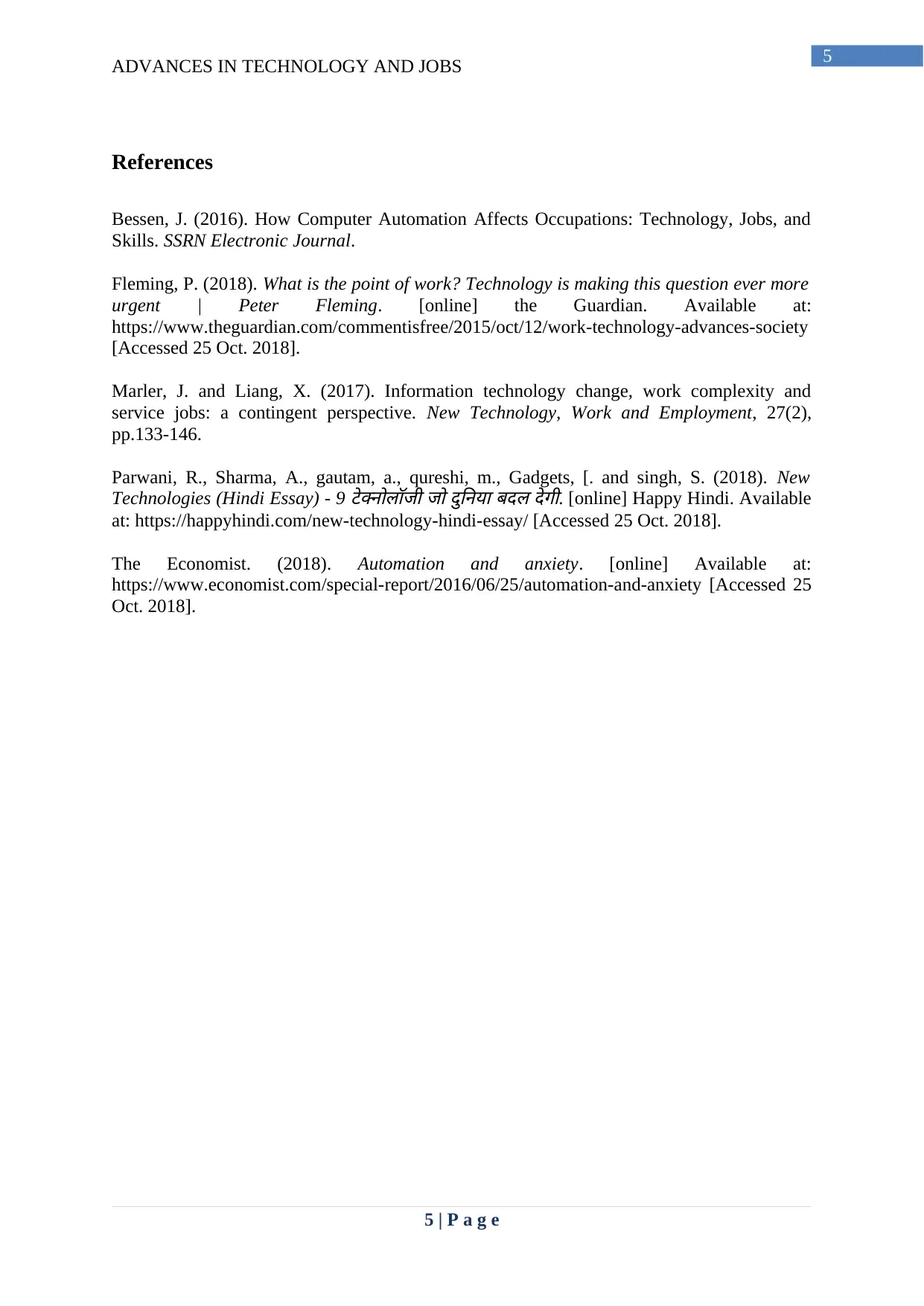
5
ADVANCES IN TECHNOLOGY AND JOBS
References
Bessen, J. (2016). How Computer Automation Affects Occupations: Technology, Jobs, and
Skills. SSRN Electronic Journal.
Fleming, P. (2018). What is the point of work? Technology is making this question ever more
urgent | Peter Fleming. [online] the Guardian. Available at:
https://www.theguardian.com/commentisfree/2015/oct/12/work-technology-advances-society
[Accessed 25 Oct. 2018].
Marler, J. and Liang, X. (2017). Information technology change, work complexity and
service jobs: a contingent perspective. New Technology, Work and Employment, 27(2),
pp.133-146.
Parwani, R., Sharma, A., gautam, a., qureshi, m., Gadgets, [. and singh, S. (2018). New
Technologies (Hindi Essay) - 9
टेक्नोलॉजी जो दु निनया बदल देगी. [online] Happy Hindi. Available
at: https://happyhindi.com/new-technology-hindi-essay/ [Accessed 25 Oct. 2018].
The Economist. (2018). Automation and anxiety. [online] Available at:
https://www.economist.com/special-report/2016/06/25/automation-and-anxiety [Accessed 25
Oct. 2018].
5 | P a g e
ADVANCES IN TECHNOLOGY AND JOBS
References
Bessen, J. (2016). How Computer Automation Affects Occupations: Technology, Jobs, and
Skills. SSRN Electronic Journal.
Fleming, P. (2018). What is the point of work? Technology is making this question ever more
urgent | Peter Fleming. [online] the Guardian. Available at:
https://www.theguardian.com/commentisfree/2015/oct/12/work-technology-advances-society
[Accessed 25 Oct. 2018].
Marler, J. and Liang, X. (2017). Information technology change, work complexity and
service jobs: a contingent perspective. New Technology, Work and Employment, 27(2),
pp.133-146.
Parwani, R., Sharma, A., gautam, a., qureshi, m., Gadgets, [. and singh, S. (2018). New
Technologies (Hindi Essay) - 9
टेक्नोलॉजी जो दु निनया बदल देगी. [online] Happy Hindi. Available
at: https://happyhindi.com/new-technology-hindi-essay/ [Accessed 25 Oct. 2018].
The Economist. (2018). Automation and anxiety. [online] Available at:
https://www.economist.com/special-report/2016/06/25/automation-and-anxiety [Accessed 25
Oct. 2018].
5 | P a g e
⊘ This is a preview!⊘
Do you want full access?
Subscribe today to unlock all pages.

Trusted by 1+ million students worldwide
1 out of 6
Related Documents
Your All-in-One AI-Powered Toolkit for Academic Success.
+13062052269
info@desklib.com
Available 24*7 on WhatsApp / Email
![[object Object]](/_next/static/media/star-bottom.7253800d.svg)
Unlock your academic potential
Copyright © 2020–2025 A2Z Services. All Rights Reserved. Developed and managed by ZUCOL.





